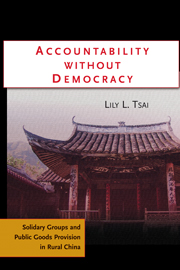Book contents
- Frontmatter
- Contents
- List of Figures
- List of Tables
- Acknowledgments
- 1 GOVERNANCE AND INFORMAL INSTITUTIONS OF ACCOUNTABILITY
- 2 DECENTRALIZATION AND LOCAL GOVERNMENTAL PERFORMANCE
- 3 LOCAL GOVERNMENTAL PERFORMANCE
- 4 INFORMAL ACCOUNTABILITY AND THE STRUCTURE OF SOLIDARY GROUPS
- 5 TEMPLES AND CHURCHES IN RURAL CHINA
- 6 LINEAGES AND LOCAL GOVERNANCE
- 7 ACCOUNTABILITY AND VILLAGE DEMOCRATIC REFORMS
- 8 THE LIMITATIONS OF FORMAL PARTY AND BUREAUCRATIC INSTITUTIONS
- 9 CONCLUSION
- References
- Appendix: Additional Notes on Survey Sampling and Data Analysis
- Index
- Cambridge Studies in Comparative Politics
6 - LINEAGES AND LOCAL GOVERNANCE
Published online by Cambridge University Press: 05 June 2012
- Frontmatter
- Contents
- List of Figures
- List of Tables
- Acknowledgments
- 1 GOVERNANCE AND INFORMAL INSTITUTIONS OF ACCOUNTABILITY
- 2 DECENTRALIZATION AND LOCAL GOVERNMENTAL PERFORMANCE
- 3 LOCAL GOVERNMENTAL PERFORMANCE
- 4 INFORMAL ACCOUNTABILITY AND THE STRUCTURE OF SOLIDARY GROUPS
- 5 TEMPLES AND CHURCHES IN RURAL CHINA
- 6 LINEAGES AND LOCAL GOVERNANCE
- 7 ACCOUNTABILITY AND VILLAGE DEMOCRATIC REFORMS
- 8 THE LIMITATIONS OF FORMAL PARTY AND BUREAUCRATIC INSTITUTIONS
- 9 CONCLUSION
- References
- Appendix: Additional Notes on Survey Sampling and Data Analysis
- Index
- Cambridge Studies in Comparative Politics
Summary
When the boundaries of a solidary group coincide with the boundaries of the local government's jurisdiction, and the group encompasses the entire locality, the group's collective goods become the same thing as public goods. The model of informal accountability thus posits that localities with embedding solidary groups that encompass everyone in a local government's jurisdiction are more likely to have better local governmental provision of public goods than localities without these groups, all other things being equal.
In this chapter, we look at lineage groups, which generally embed village officials in their activities but vary in scale, and whether or not they encompass a local governmental jurisdiction. By looking at a single type of solidary group, we can hold numerous group characteristics constant – lineage groups have similar principles of organization, similar kinds of collective activities, similar types of membership criteria – and see what happens when the scale of the group and its fit with political administrative boundaries vary. If the hypothesis is correct, we should expect villagewide lineages to be more likely to have a positive effect on village governmental provision of public goods. Lineage groups, however, which fragment a village into subvillage groups, should be less likely to have this kind of positive effect.
- Type
- Chapter
- Information
- Accountability without DemocracySolidary Groups and Public Goods Provision in Rural China, pp. 148 - 186Publisher: Cambridge University PressPrint publication year: 2007

